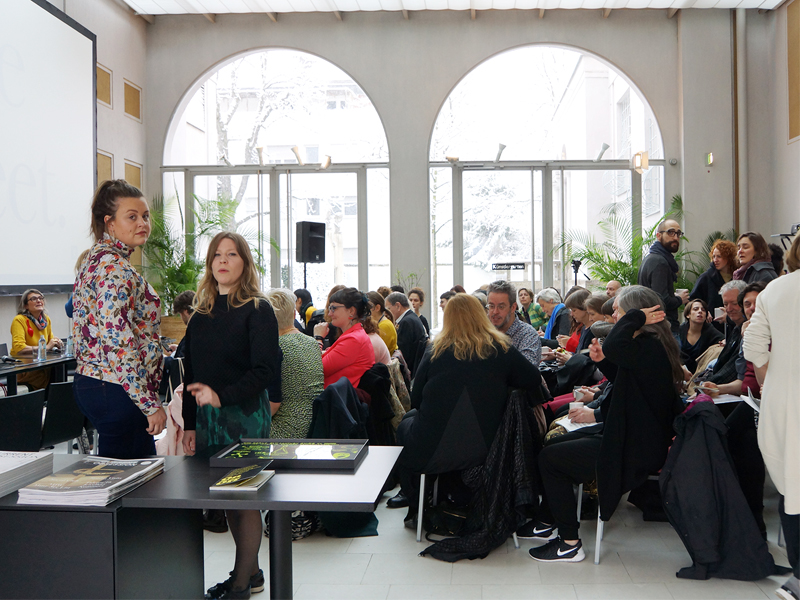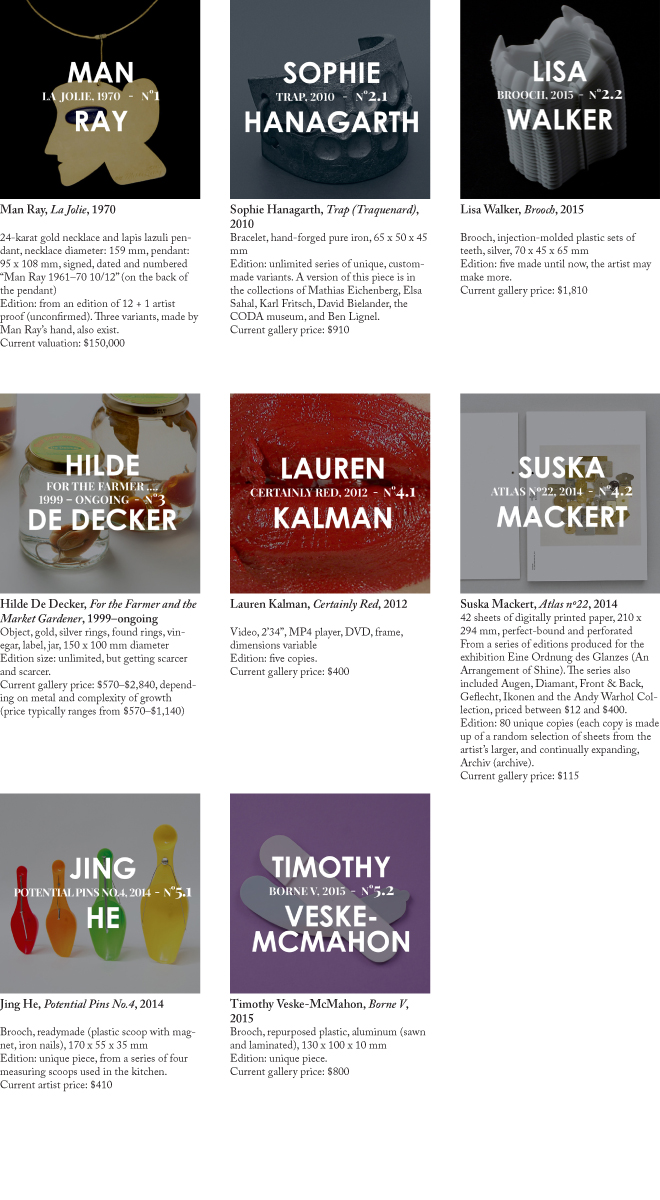
Why do collectors pick an artist over another? Or choose this piece by an artist, when that other piece is clearly more spectacular? How do curators select works for exhibitions, and artists decide to swap work with another artist? Do we know what their criteria are? Can we assume that they are the same?
During Munich Jewelry week 2016, AJF editor Benjamin Lignel presented several works to a panel of “deciders.” One maker (David Bielander), one collector (Susan Cummins), one freelance curator and historian (Liesbeth den Besten), and one museum curator (Petra Hölscher) got to choose from eight works of contemporary jewelry, and explain, in public, why they would include them in their collection.
This is the second time AJF has organized such a panel. The first version, staged during Joya 2015 in Barcelona, was a great success: It allowed the audience (and the participants) to understand just how irrational acquisition decisions are, and how differently we all think about “getting work.” Like the first time, a few days in advance the panelists received a detailed description of each of the works they were going to see during the panel. This report included a small overview of the artist’s career, a full caption of the work at hand (including edition size), and its current sale price.
The eight works presented in this panel—some in pairs—were chosen to raise specific issues concerning collecting, in order to cast some light on the often unspoken criteria that preside over collectors’ and curators’ selections of work. As always, asking different voices to contribute to the same conversation proved a fruitful strategy for understanding what we mean by “caring for contemporary jewelry.”
2016 MJW Collector Panel from Art Jewelry Forum on Vimeo.
The Work

The Panel
David Bielander, maker, collector
David is a maker—he trained in Switzerland, then in Schwäbisch Gmünd, and finally under Professor Otto Künzli at the Academy of Fine Arts in Munich from 2006–2010. He has recently been recognized with prestigious prizes: the Munich Förderpreis in 2009; the Herbert Hofmann Prize in 2010; the Françoise van den Bosch Prize in 2012; and the Bavarian State Prize in 2015. His work is represented in no less than 18 public collections.
David is one of the very few contemporary jewelry makers who is able to support himself principally from the sale of his work. He is keenly aware of the importance of collectors—both private and institutional—to move this field forward. He buys and occasionally swaps work, and his criteria for choosing have a lot to do with his own practice.
Susan Cummins, collector, AJF board chair
Susan has spearheaded the development of a national organization of jewelry collectors, Art Jewelry Forum, which was started in conjunction with the San Francisco Craft and Folk Art Museum and has since separated into its own nonprofit organization. She oversaw the organization’s growth from a small group of collectors to an international content provider (AJF currently publishes 12 articles a month, one book every year, and has a staff of five). Before that, Susan ran her own gallery in Mill Valley, California, where she presented artwork by accomplished as well as emerging artists.
Susan is currently the vice-chair of the California College of the Arts, and a board member of the Center for Craft, Creativity & Design. She owns one of the largest American collections of contemporary jewelry, which she has built over the last 14 years. It is housed in custom-built cabinets nestled under a large felt panel which can be used for the temporary display of part of her collection. She never wears jewelry.
Liesbeth den Besten, collector, independent historian, lecturer, freelance curator
Liesbeth is the chairwoman of the Françoise van den Bosch Foundation for contemporary jewelry, a member of the advisory board of the Chi ha paura…? Foundation, a founding member of Think Tank, a European Initiative for the Applied Arts, and a board member of AJF. Her most recent book, On Jewellery: A Compendium of International Contemporary Art Jewellery, was published by Arnoldsche Art Publishers in November 2011. Together with Ruudt Peters and four others, she is the initiator of SSC, a foundation for private jewelry collections in the Netherlands.
She has been very seriously thinking, for many years, about the problem of keeping private collections intact after the passing of their owners, and their conservation in the public domain. This is a huge concern in Europe, where the habit of gifting to museums is not as common as it is in the US. She started collecting jewelry with her husband, Jim, in 1982—and the collection comprises both historical Dutch works and contemporary pieces. They prefer to buy work by emerging artists, but they also have a focus on Dutch work from 1967–1975.
Benjamin Lignel, editor, curator, maker
An art historian (BA) and furniture designer (MA) by training, Benjamin veered toward jewelry design as soon as he earned his master’s. He was appointed editor of Art Jewelry Forum in 2013, and has just edited a third book, titled On and Off, under AJF’s imprint.
Benjamin has accrued a collection by swapping his own work for the work of makers he appreciates, and adding to this with occasional purchases. His collection is housed in a pair of custom-built mobile book/display cases. He wears jewelry on special occasions.
Petra Hölscher, senior curator, Die Neue Sammlung, since 2007
Dr. Petra Hölscher studied art history, Romance languages, literature, and industrial anthropology in Kiel, Germany, and her first curatorial focus was furniture. She started working at Die Neue Sammlung as curator in 2002, and her focus shifted to the field of studio jewelry in 2009. At first, she worked more in the background, organizing exhibitions, but in recent years she has been more and more responsible for the exhibition program, the purchases, contacts, and research.




